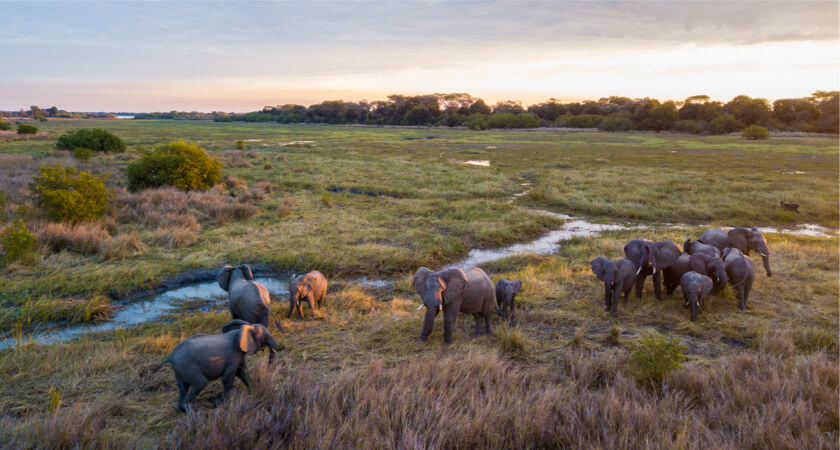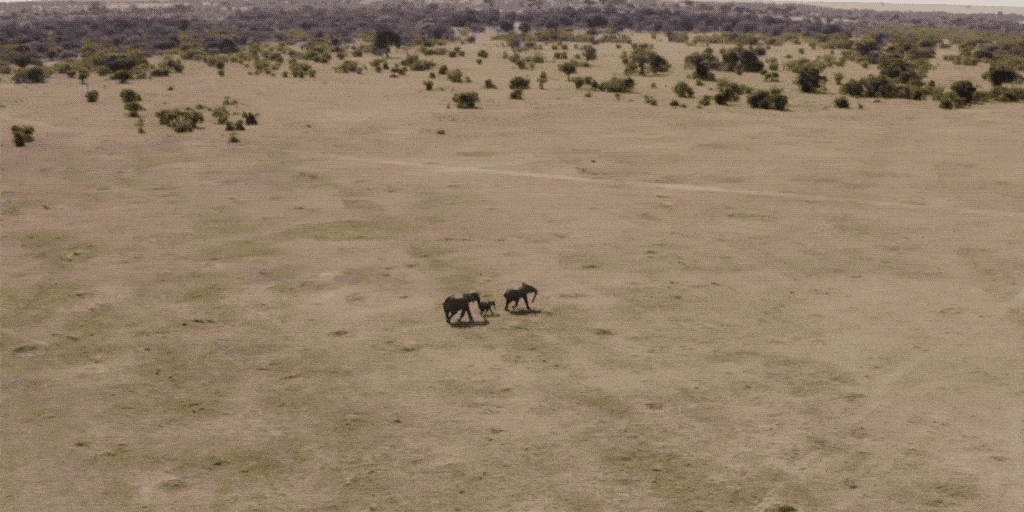Poachers slaughter between 20,000 and 40,000 elephants every year; that is one elephant killed every 15 minutes. For the last decade, elephant mortalities due to poaching are now exceeding the rate at which they are able to reproduce. Despite the international ban on ivory trade, its demand remains high, especially in Asia, where it is used in traditional medicine or is seen as a symbol of prestige and wealth. Black market ivory trafficking is hugely profitable and the growing sophistication of illegal wildlife trade has led to the population of African elephants to drop from 1.3 million in 1970 to only 400,000 today.1
In addition to poaching, Human-Elephant Conflict (HEC) is also a major threat to both elephants and humans. As the forest wildlands in which elephants live have steadily shrunk, and as human populations have grown, conflict is increasingly common as humans and elephants clash over space; a battle the elephant is losing.

Poaching: devastating damage to elephant populations
Inadequate anti-poaching capability, ineffectual law enforcement, and corruption often undermine the struggle against poaching and trafficking in some countries.
With male tusks around seven times the weight of those of females, bull elephants are the poachers' main targets. Despite this, female African elephants are also killed. This has led to the instability of elephant societies, leaving a growing number of orphaned baby elephants.
Asian elephants are less prone to poaching than African elephants as only some Asian males have tusks. However, it is said that ivory carvers prefer Asian ivory, believing it to be of a higher quality. Real or perceived, this preference exists and creates a higher demand for Asian elephant tusks. This has meant there are now less than 40,000 remaining worldwide; a tenth of the African elephant population.2
Non-poacher killings of elephants for meat alone are rare but elephant hide is highly valued with clothing and furnishings made of elephant leather sold in boutiques across Asia and the US.
Combating elephant poaching with drones
In recent years, anti-poaching drones have been a useful and innovative addition to the various methods of contesting illegal hunting. One organization that is utilizing conservation drones to reduce both poaching and HEC is the Mara Elephant Project that focuses on elephant protection in the Maasai Mara, Kenya.
Poachers prefer to hunt in the late afternoon so they can use the last of the light to make their kills and escape under the cover of darkness.
The anti-poaching drones, like the Mavic 2 Enterprise Dual or the Mavic 2 Enterprise Zoom, used by the Mara Elephant Project, with their cameras capable of 30x zoom or thermal imaging, now make it easier to locate the poachers during the day and at night. These onboard cameras relay live video to ground-based teams, often safely miles away, and can record footage for later analysis. The conservation teams can then share their monitoring with rangers and police.
The organization has arrested hundreds of poachers and seized over 1,000 kg of ivory since its launch. According to Mara Elephant Project CEO Marc Goss, “we have reduced the percentage of illegally killed elephants from 83% to 44%, meaning that elephants are more likely to live out their lives naturally in the wild.”
The rise of human-elephant conflict
In recent years HEC has experienced a considerable intensification to become a major issue in the struggle to protect endangered elephants. The rise has been the result of the inexorable increase of the human population and the resulting damage, fragmentation, and isolation of elephant habitats. As a result, elephant populations are progressively turning to crop raiding for sustenance.
In Asia, for example, many areas of elephant habitat are neighboring or adjoining towns and villages. The subsequent conflict has meant that every year, between 100-300 people and 40-50 elephants are killed during crop raiding in India alone.3

How drones help minimize human-elephant conflict
Drones are not only aiding in anti-poaching efforts, but are also being deployed to help prevent human-elephant conflict.
In China, to combat a growing population of elephants that began to encroach on villages in the Yunnan province, drones were used to monitor the animals to preemptively avoid conflict. Thermal drones were operated to detect elephants straying close to human settlements and the locations were posted to an elephant warning platform online. Road signs were also deployed in areas of repeated elephant activity, identified by the drones, to forewarn drivers so they could choose alternate routes.
With the human population of the Maasia Mara growing by 10% every year, their encroachment into the local elephants’ habitat is inevitable. This has led to loss of property and crops as the elephants react to the incursion and even loss of life for both people and elephants. The Mara Elephant Project uses drones, as just one of the tools in their initiative, to help herd elephants away from danger.
 https://maraelephantproject.org/
https://maraelephantproject.org/
“Drones play a significant role in our work. We use drones for precise, cost-effective elephant management.” - Marc Goss, Mara Elephant Project CEO.
The drones are used in a similar way to how dogs herd sheep. The noise made by the drone sounds like a swarm of bees to the elephants and will make them alter course. This enables members of the project’s team to steer the elephants clear of nearby villages or poaching ‘hot zones’. The data is also collated and the subsequent wildlife mapping can be continuously updated.

Look to the future, look to the sky
Anti-poaching and conservation drones are being successfully employed to mitigate the terrible loss of elephants for their tusks and the growing problem of HEC. Drones can go quickly, safely, and with minimal cost, where humans would be extremely at risk.
***
For more information and to donate, click here: https://maraelephantproject.org/donate/
For further reading, learn how drones are protecting koalas from habitat loss and watch this video on how the endangered bears are being accurately located and counted.
Sources:
1. https://www.elephantsforafrica.org/
2. https://worldelephantday.org/
3. https://wwf.panda.org/discover/knowledge_hub/endangered_species/elephants/human_elephant_conflict/?


.png?width=300&name=L3kv%20(1).png)

.png?width=300&name=FH2%20update%20(1).png)
-1.png?width=300&name=HS%20-%20Featured%20Images%20(3)-1.png)